Wai‘anae Valley Cesspool Conversion Pilot Project
Wai‘anae Valley Cesspool Conversion Pilot Project
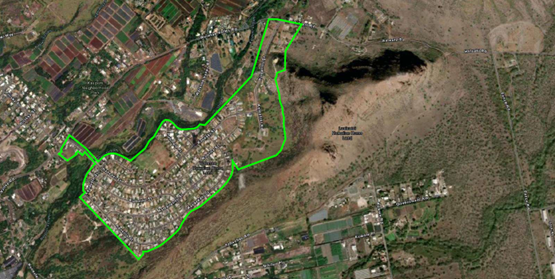
MEETING NOTICE:
Wai‘anae Valley Cesspool Conversion Meeting :
Thursday, June 26, 6:00 p.m. to 8:00 p.m.
**Lessees connected to city sewer system, do not need to attend.
Attend In Person
Mā‘ili Community Learning Center
87-790 Kulauku Street
Wai‘anae, HI 96792
Zoom link: https://dhhl-hawaii-gov.zoom.us/j/88206147213?pwd=fD5ktIGUV2YDeKGTTLvpPxQ4ifE4aJ.1
Meeting ID: 882 0614 7213
Passcode: 121
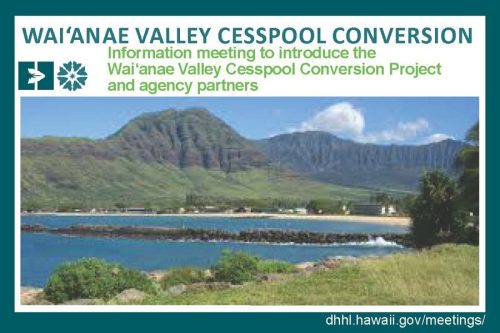
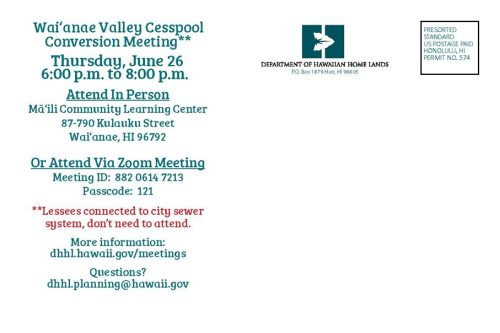
The project team aims to understand the experience and perspective of residents in Waianae Valley Homestead, explain project specifics, timelines, potential wastewater solutions to be evaluated, and share what the community can expect from the project. Please see Closing America’s Wastewater Access Gap Initiative below for more information.
Background on Cesspool Conversion: Governor David Ige signed Act 125 into law in 2017, requiring the upgrade, conversion, or sewer connection of all cesspools in the State before January 1, 2050. The primary goal of this mandate is to eliminate the negative potential impacts on the environment and human health from existing cesspools. Across the state there are roughly 83,000 cesspools, and 7,500 on Oahu. Cesspools contaminate groundwater and drinking water sources, with excess nutrients and harmful pathogens posing a threat to public and environmental health.
What is a Cesspool? Cesspools are shallow underground systems used to dispose of untreated sanitary waste. The systems vary but largely consist of a concrete cylinder that has an open bottom and may include perforated sides. These systems are used to collect and then drain out sewage from toilets, sinks, and washing machines. The discharge of untreated waste into a cesspool can have a variety of negative potential impacts on human health, including the contamination of drinking water and probable damage to land or aquatic ecosystems.
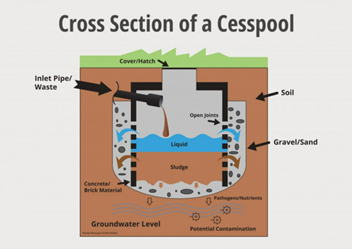
Cesspool Assessment Report: In 2023 and 2024, a cesspool assessment was conducted for the island of O‘ahu to identify existing cesspool on DHHL lands and recommend conversion and connection options.
The map below shows survey results for the Wai‘anae Homestead area. There are 102 confirmed lots with cesspools. Of the remaining lots, 5 lots are on septic, 3 lots are connected to sewer, 7 lots are vacant, and 37 lots were inaccessible for this assessment.
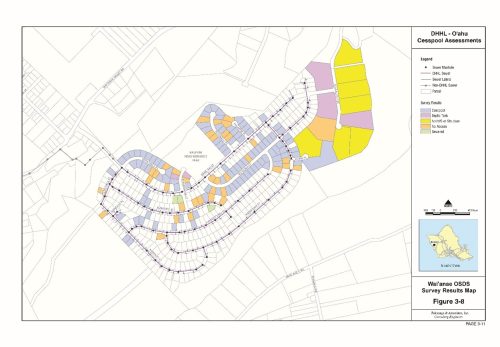
Though completed, the assessment is awaiting publication.
Closing America’s Wastewater Access Gap Initiative: The Closing America’s Wastewater Access Gap Initiative provides no-cost technical assistance to communities with failing septic systems, cesspools, or without existing wastewater infrastructure. Within the Wai‘anae Valley Homestead Community project area, there are roughly 102 cesspools. In partnership with the Environmental Protection Agency (EPA), Department of Hawaiian Home Lands (DHHL) local Technical Assistance (TA) providers and engineers will evaluate alternatives for cesspool conversions.
This project will help DHHL and the Wai‘anae Valley Homestead Community get the information and resources needed to identify the right type of wastewater system(s) for the community and to position them to apply for federal funding. The local community will provide input and feedback on the solutions that best fit their needs. The project team is diverse and includes providers that the community can work with to identify and plan wastewater solutions, provide education and outreach, and assist with applying for funding.
February 3, 2025, Community Meeting: On February 3, 2025, a community meeting was held by DHHL, without other agencies, to meet with the Wai‘anae Valley Homestead Community with four main goals:
- Provide background on the need for cesspool conversion and preliminary cesspool options.
- Share findings and recommendations in the Cesspool Assessment Report.
- Reaffirm DHHL’s commitment to work with other agencies to secure funding to help lessees pay for conversions.
- Answer questions, gather comments, and note concerns.
You may find the presentation slides here.
Meeting notes may be found here.
Approximately 65 people showed up for the meeting. Due to unfortunate circumstances, the EPA and their consultants were unable to attend this meeting. However, they have been working with DHHL staff to answer some of the questions gathered at the meeting. Those responses are still being finalized and will be posted here upon completion.
For more information, please contact [email protected].